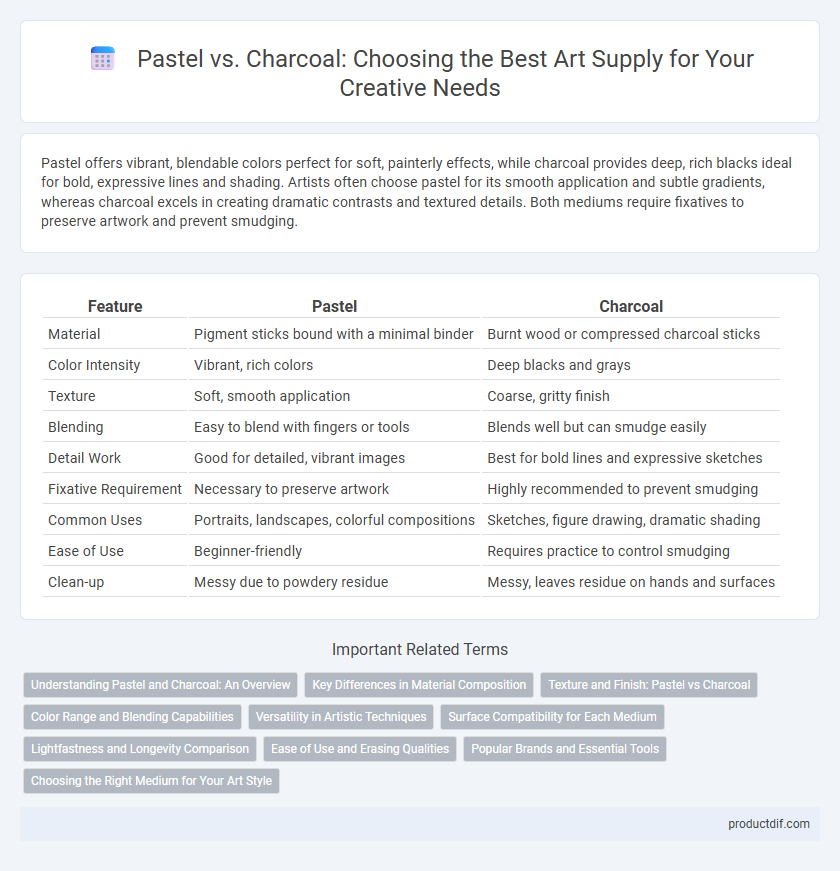Pastel offers vibrant, blendable colors perfect for soft, painterly effects, while charcoal provides deep, rich blacks ideal for bold, expressive lines and shading. Artists often choose pastel for its smooth application and subtle gradients, whereas charcoal excels in creating dramatic contrasts and textured details. Both mediums require fixatives to preserve artwork and prevent smudging.
Table of Comparison
| Feature | Pastel | Charcoal |
|---|---|---|
| Material | Pigment sticks bound with a minimal binder | Burnt wood or compressed charcoal sticks |
| Color Intensity | Vibrant, rich colors | Deep blacks and grays |
| Texture | Soft, smooth application | Coarse, gritty finish |
| Blending | Easy to blend with fingers or tools | Blends well but can smudge easily |
| Detail Work | Good for detailed, vibrant images | Best for bold lines and expressive sketches |
| Fixative Requirement | Necessary to preserve artwork | Highly recommended to prevent smudging |
| Common Uses | Portraits, landscapes, colorful compositions | Sketches, figure drawing, dramatic shading |
| Ease of Use | Beginner-friendly | Requires practice to control smudging |
| Clean-up | Messy due to powdery residue | Messy, leaves residue on hands and surfaces |
Understanding Pastel and Charcoal: An Overview
Pastel and charcoal are popular art supplies distinguished by composition and texture, with pastels made from pigment and a binder forming vibrant, blendable sticks, while charcoal consists of carbonized wood offering deep, rich blacks and expressive lines. Pastels allow for smooth layering and color mixing, ideal for detailed and colorful artwork, whereas charcoal excels in creating bold contrasts and textured effects, commonly used in sketches and dramatic portraits. Understanding the unique characteristics of pastel and charcoal helps artists select the right medium for their artistic expression and technique preferences.
Key Differences in Material Composition
Pastels consist primarily of pigment combined with a binder such as gum arabic or methylcellulose, resulting in a soft texture ideal for blending vibrant colors. Charcoal is made from charred organic wood or vine, creating a dry and brittle medium that produces rich blacks and subtle grays. The composition of pastels allows for smooth, malleable strokes, whereas charcoal's material yields more textured, expressive marks.
Texture and Finish: Pastel vs Charcoal
Pastel offers a soft, powdery texture that produces vibrant, blendable colors with a matte finish, ideal for detailed layering and smooth transitions. Charcoal provides a gritty, coarse texture that creates rich, deep blacks and dynamic shading with a velvety, matte finish, perfect for expressive, bold strokes. The finish of pastel emphasizes luminosity and color richness, while charcoal focuses on strong contrasts and dramatic depth.
Color Range and Blending Capabilities
Pastels offer a vibrant and extensive color range, allowing artists to achieve rich, layered hues that enhance visual depth. Charcoal is primarily monochromatic, excelling in creating dramatic contrasts with deep blacks and subtle grays. Both mediums provide smooth blending capabilities, but pastels blend seamlessly to produce soft transitions, while charcoal enables bold smudging for expressive shading effects.
Versatility in Artistic Techniques
Pastels offer a broad range of colors and blending possibilities, making them ideal for detailed shading and vibrant layering in various artistic styles. Charcoal excels in creating bold contrasts and dynamic textures, perfect for expressive sketches and dramatic shading effects. Both mediums provide unique versatility, allowing artists to experiment with softness, intensity, and depth in their work.
Surface Compatibility for Each Medium
Pastels perform best on textured or toothy surfaces like pastel paper or sanded boards, which help grip the pigment particles for vibrant, blendable colors. Charcoal requires a similarly textured surface but excels on heavier-weight papers or toned papers that allow for deep blacks and smooth shading. Both mediums demand an appropriate tooth to hold the medium effectively, but pastel prefers rougher surfaces while charcoal can adapt well to slightly smoother textures for detailed work.
Lightfastness and Longevity Comparison
Pastels typically offer moderate lightfastness, with high-quality artist-grade options providing greater resistance to fading over time compared to student-grade variants, making them suitable for long-term display under controlled lighting. Charcoal, while prized for its rich, deep blacks and blending capabilities, generally exhibits lower lightfastness and is more susceptible to smudging and deterioration without proper fixatives and protective framing. Artists prioritizing longevity often choose archival-grade pastels combined with fixatives or sealed charcoal works to ensure preservation of the artwork's integrity over decades.
Ease of Use and Erasing Qualities
Pastels offer smooth application and blend easily, making them beginner-friendly, while charcoal can be messier and requires more control to achieve detailed work. Erasing pastels is relatively effective on textured paper, allowing for adjustments and highlights, whereas charcoal erases more cleanly but can smudge easily, affecting overall precision. Both mediums require fixatives to preserve artwork, with pastels generally demanding less frequent application.
Popular Brands and Essential Tools
Popular brands for pastel art supplies include Sennelier, Faber-Castell, and Rembrandt, offering a variety of soft, hard, and oil pastels tailored for vibrant color blending and smooth application. In charcoal supplies, General's Charcoal, Winsor & Newton, and Prismacolor provide essential tools like compressed and vine charcoal sticks, charcoal pencils, and blending stumps for achieving rich, deep blacks and fine details. Essential tools for pastels often incorporate pastel paper and fixatives, while charcoal artists rely on erasers and textured papers to enhance shading and contrast.
Choosing the Right Medium for Your Art Style
Pastels offer vibrant, blendable colors ideal for soft transitions and detailed work, making them perfect for artists focused on realism and color depth. Charcoal provides rich, deep blacks with expressive, bold strokes suited for dramatic contrasts and sketch-like textures, appealing to artists who prioritize dynamic shading and immediacy. Selecting between pastel and charcoal depends on your desired effect, color use, and whether you prefer smooth blending or strong, graphic lines in your artwork.
Pastel vs Charcoal Infographic

 productdif.com
productdif.com